It’s not uncommon for a beginner to try and stay well clear of the gym. It’s expensive, inconvenient, and can even be downright intimidating! So does that mean your chances of building muscle are doomed? Fortunately, not! This post explains why and how you can gain muscle without the gym.
It is completely possible to gain muscle without going to the gym. Home workouts can be a great alternative for building muscle without a gym membership. Popular ways to train at home include; bodyweight exercises, resistance bands, dumbbells, kettlebells, and even barbells.
I gained my first 10lbs of muscle at home as a beginner, before switching to the gym.
So i know it’s completely feasible!
But don’t just take my word for it!
Below, I’ll share tips and scientific evidence showing that you don’t even need weights to build muscle at home!

- Do You Need A Gym To Build Muscle?
- Bodyweight Vs Free Weights: Which Is More Effective For Building Muscle?
- Why You Can Gain Muscle At Home Without Gym Equipment
- 9 Tips To Build Muscle At Home Without Gym Equipment
- You Can't Gain Muscle Without Weight Training!
- Are Home Workouts Better Than The Gym?
- Conclusion
Do You Need A Gym To Build Muscle?
A gym is not essential to gain muscle. It is completely possible to build muscle by training at home without having to buy gym membership. Home workouts can utilize bodyweight exercises or cheap equipment such as dumbbells and resistance bands.
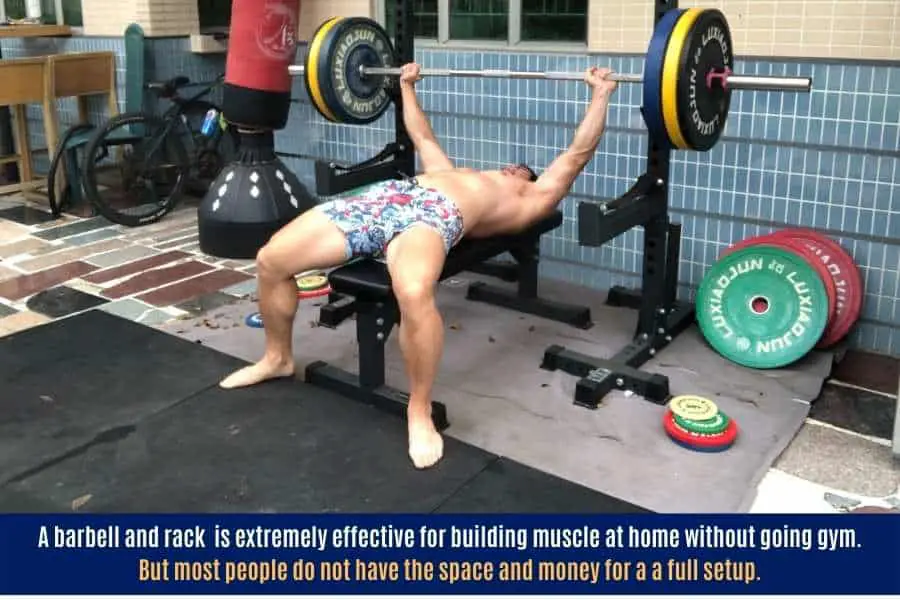
When asking whether or not you need to go to the gym to build a muscular V-shaped body, we need to ask WHY people go to the gym in the first place.
Most people use the gym for free weights or machinesby the way…
So the next logical option for those not wanting to buy a gym membership would be to get a home gym.
But a full-blown barbell setup is unrealistic for most people.
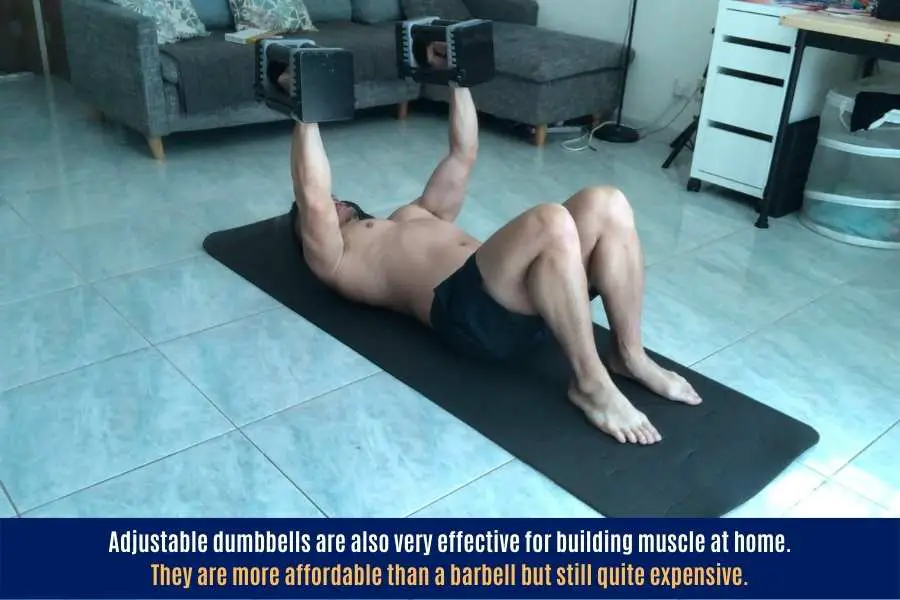
Now, dumbbells are much more realistic. I use the Powerblock Elites and they’re awesome for building muscle at home. They’re much more affordable than a dumbbell, take up less space, and are heavy enough for most people to gain muscle. But they’re by no means cheap.
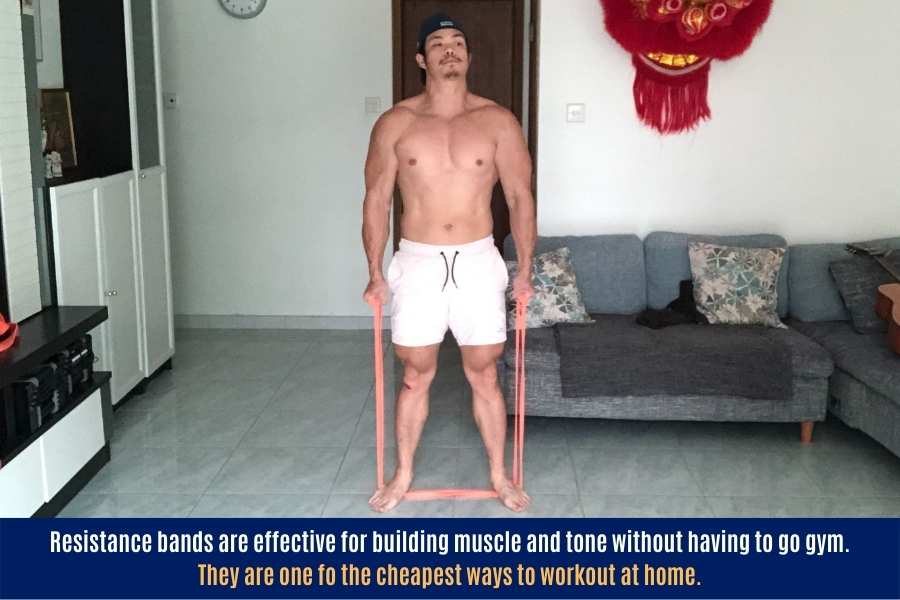
Then you also have resistance bands. I have the Undersun bands. Whilst I generally find weights better than bands for building muscle at home, you can’t deny bands are an extremely cost-effective way to tone and sculpt your body at home.
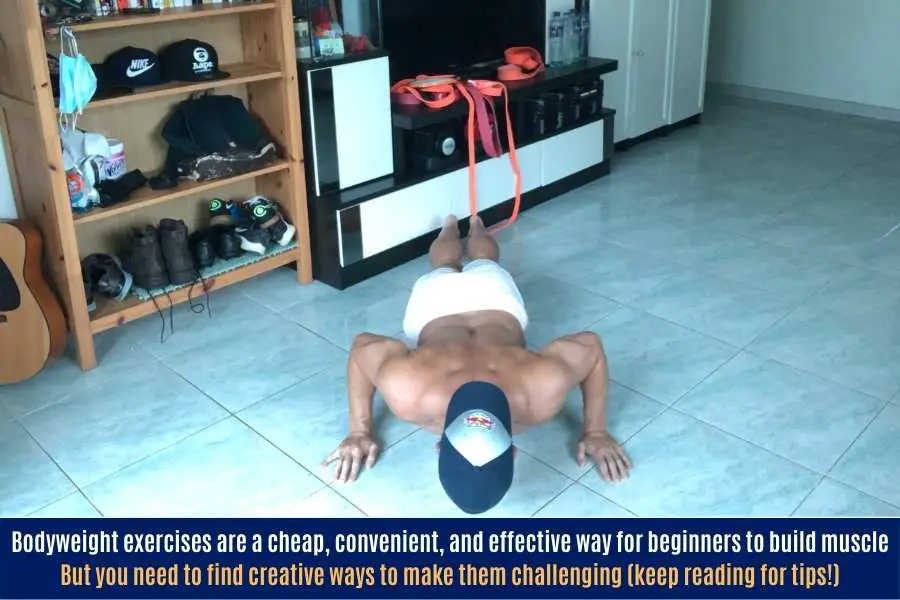
And finally, we have bodyweight training. This is by far the cheapest and most convenient way to build muscle at home without going to the gym. We all know this right?
But I’m sure many of you are asking- “just how effective is bodyweight training?” and “are weights or bodyweight exercises better for building muscle?”.
It turns out bodyweight training can be just as effective as weights to build muscle.
You can keep reading for the scientific evidence to support this claim!
Bodyweight Vs Free Weights: Which Is More Effective For Building Muscle?
Bodyweight training can be as effective as free weights for beginners to build muscle. These types of exercises are sufficient to promote muscle growth and are usually easier and safer to do compared to using weights. However, weights are usually better for maximal muscle gains.
There’s no denying weights reign supreme for outright maximal muscle and strength gains.
After all, there’s a reason why bodybuilders, powerlifters, and strongmen all lift weights rather than do bodyweight training.
But that’s not to discredit bodyweight workouts.
They CAN still be highly effective for building muscle; especially for beginners. Check out the below studies that support this case:
- 2017 study– 18 men were randomly assigned one of two training regimes: barbell bench press (at 40% of 1-rep max) or push-ups. Each group completed 8 weeks of training. Upper body muscle size and strength were measured. Both groups made similar muscle size and strength gains.
- 2015 study– looked at how 5-week dumbbell bench press vs push-up regimes affected upper body pushing strength in 30 men and women. Both groups made comparable strength gains when loading was similar.
- 2021 study– two identical twins performed a 10-week full-body regime. One twin used weight whilst the other twin used bodyweight-only. Both twins built a similar amount of muscle (the twin who used weights built slightly more muscle).
- 2020 study– concluded that push-ups are an effective way for novices to start a resistance training program. They proposed that push-ups (and bodyweight movements) are a great way to get started, before progressing onto the weighted versions (e.g. the bench press).
“Since there is greater stability, no chance of injury from erratic movements of dumbbells or barbells and very little motor learning involved with push-ups, [they] are an excellent exercise for progressing [onto] a bench press exercise.”
Alizadeh et Al. 2020.
Why You Can Gain Muscle At Home Without Gym Equipment
It is possible to gain muscle at home without gym equipment. Three types of stimuli promote muscle growth; mechanical tension, metabolic stress, and microtearing. Bodyweight training can be sufficient to present all 3 stimuli if it is done at a high enough intensity.
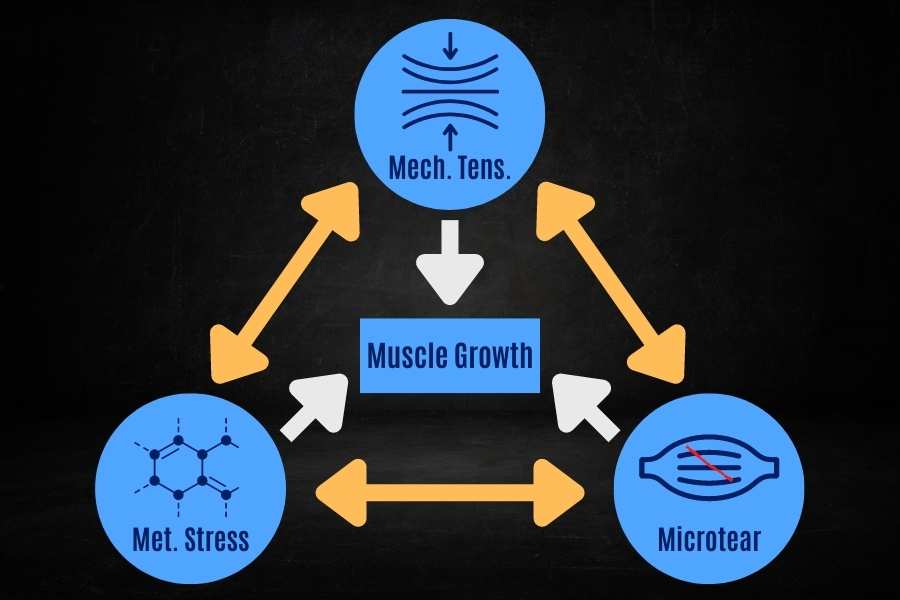
Let’s dive deeper into each muscle-builing- also known as hypertrophy– stimuli and how they are achieved:
- Mechanical tension. This usually comes directly from the amount of weight lifted. The more weight loaded onto a muscle the higher the resistance it has to fight against and the greater the mechanical tension. The greater the mechanical tension, the more metabolic stress, and microtears form in your muscles, and the greater the hypertrophy response.
- Metabolic stress. This is most commonly felt as the “burning” lactic acid sensation after a particularly intense set. It comes about from mechanical tension but also the amount of time your muscles remain contracted (also known as time under tension). Both stimuli exhaust your muscles and cause waste products (like lactic acid) to accumulate in the muscle. This contributes to microtearing and inflammation, both of which promote hypertrophy.
- Microtears. These are microscopic trauma in your muscle fibers. They come about as a result of mechanical tension and microtears. Microtears initiate cellular and molecular repair responses in your muscle cells. They grow back bigger and stronger than in their uninjured state.
Whilst weights are a popular way to present all 3 stimuli to your muscles, bodyweight exercises can do the same.
However, after a certain point, it becomes hard to overload your muscles with more mechanical tension.
That’s because you’re limited by your own body weight, unlike with a barbell which offers near-unlimited weight for you to add.
But it’s possible if you know how…
Keep reading for creative ways to maximize bodyweight training intensity!
9 Tips To Build Muscle At Home Without Gym Equipment
Bodyweight exercises can be extremely effective, especially for beginners.
But as I mentioned before, it can be hard to overload your muscles with weight and mechanical tension on bodyweight exercises.
And overloading is key for breaking through plateaus and promoting continued muscle growth.
The good news is you can use various tricks and bodyweight training techniques to make your muscles work harder without having to use weights (effectively fooling your muscles into thinking they’re lifting more weight than they are).
Here are 9 tips to lift your body weight to build muscle without a gym, weights, or other equipment:
1) Increase reps and sets to increase metabolic stress
Increasing the number of reps and sets you perform for each muscle per workout is the easiest way to increase time under tension (TUT).
And increasing TUT is one of the best ways to induce greater metabolic stress on your muscles.
Your bodyweight exercises will feel much harder to complete.
But they will be much more effective for building muscle.
Increase reps and sets, but avoid exceeding more than 20 reps per set (the threshold for cardio rather than strength gains) and 6 sets per exercise per workout (the threshold for “wasted sets” in bowdyweight training).
2) Decrease rest time to increase metabolic stress
This is another simple way to make your bodyweight exercises more effective to gain muscle without the gym.
Most people take 2-3 minutes to rest between sets in a traditional weight-based muscle-building program.
Try lowering that to 1 minute with a bodyweight program.
Your muscles will have to work much harder every set if you deny them a fuecovery.
This is a great way to ramp up the metabolic stress and promote hypertrophy.
3) Decrease rep tempo to increase metabolic stress
Rep tempo describes how long it takes for you to complete each rep.
Most people lift in a 3010 tempo- meaning it takes 3 seconds on the eccentric (lowering) phase and 1 second on the concentric (raising) phase.
Try decreasing to a 3030 tempo. In other words, count for 3 seconds on the eccentric and concentric phases.
In a push-up example, you would count 3 seconds as you push up and another 3 seconds as you lower yourself toward the floor.
Those 2 extra seconds per rep are plenty to increase time under tension and ramp up the metabolic stress put on your muscles.
Result?
Increased muscle growth!
4) Introduce angles to increase mechanical tension
Angles refer to the incline and decline variations of an exercise.
For example- flat push up, incline push up, and decline push up.
Beginners rarely work from different angles during the early stages of training.
This means their muscles are usually naive to these angles and forcing them to work under this novel stimulus effectively increases the perceived weight put onto that muscle.
Additionally, angles are also great for emphasizing different regions of the same muscle.
For example- the incline push-up emphasizes the development of the upper chest.
5) Do rep pauses to increase metabolic stress
This is another easy but effective way to increase bodyweight exercise difficulty and make it more effective to gain muscle without going to the gym.
Introduce a split-second pause halfway or at the bottom of a rep (or both).
Once you’ve mastered this you can prolong the pause to 1-4 seconds.
Paused reps serve 2 purposes:
- Increases metabolic stress by increasing time under tension.
- Increases mechanical tension by removing momentum from each rep.
Both will serve you well in increasing exercise difficulty and building more muscle!
6) Do explosive reps to increase mechanical tension
Explosive reps are a great way to introduce plyometrics to your bodyweight training.
Plyometrics refers to using different speeds and forces within the same rep to build muscular power and strength.
Clapping push-ups are a good example of explosive plyometric bodyweight training.
Explosively pushing your body off the ground and putting your arms back out to cushion the fall introduces a completely novel elastic stimulus for your muscles to adapt to.
Explosive jump squats serve a similar role for the lower body.
Both are great ways to gain more muscle at home without having to go to the gym!
7) Switch to unilateral exercises for greater mechanical tension
Just because you’ve progressed past the beginning stages of bodyweight training doesn’t mean you have to plateau.
Why not simulate a weight increase by switching to a unilateral variation of the same exercise?
Unilateral means you’re working one side of your body at a time.
One-handed push-ups and pistol squats are good examples of unilateral variations of popular bilateral exercises (normal push-ups and squats).
Since you’re only using one arm or leg to push, you’re effectively doubling your bodyweight!
8) Increase range of motion to increase mechanical tension
Range of motion (ROM) refers to how far your limbs travel around the joint in a rep.
In a push-up example, the amount of you raise and lower yourself from the floor is your ROM.
In a squat example, how far your butt moves towards and away from the floor is your ROM.
Increasing ROM also increases the amount of weight you’re muscle is moving.
So this is an effective way to introduce more mechanical tension to your muscles and promote more muscle growth.
How can you increase your ROM?
Try doing push-ups holding dumbbell handles or squats on two small stacks of books!
9) Add rotation movements to exercises
Most exercises take place in the frontal (front and back) and sagittal (side to side) planes.
But there’s also one more plane; the transverse (rotational) plane.
This is often neglected.
So why not introduce rotational movements into your bodyweight exercises to make them harder?
For example, you could do a left-right twist during a sit-up or squat.
Asa bonus, rotation movements often work the core.
So this can also help you to build those 6-pack abs!
These are just some exercise techniques to gain muscle without going to the gym. If you’re interested, you can check out my other post for a full skinny guy workout program to build muscle at home!
You Can’t Gain Muscle Without Weight Training!
Muscles cannot be gained without working out. Weight training in one form or another is an essential component for building muscle. There are many methods of resistance training including; bodyweight, bands, cable machines, and free weights.
This may be obvious to some, but I thought I’d make it very clear for those who don’t know.
You can’t gain muscle without working out!
Muscle is an adaptive tissue, meaning it can only get big if you give it a stimulus (i.e. a workout) to adapt to!
Bodyweight workouts are a great way for beginners to start building muscle by before progressing onto bands, weights, and machines.
Not sure if you’re building muscle? You can check out my other post for the biggest telltale signs of muscle and strength gain!
Are Home Workouts Better Than The Gym?
Home workouts can be better than the gym for beginners. Working out at home is a cheaper and more convenient alternative to working out at a gym. However, a gym usually offers a much greater variety of equipment to choose from and access to much heavier weights.
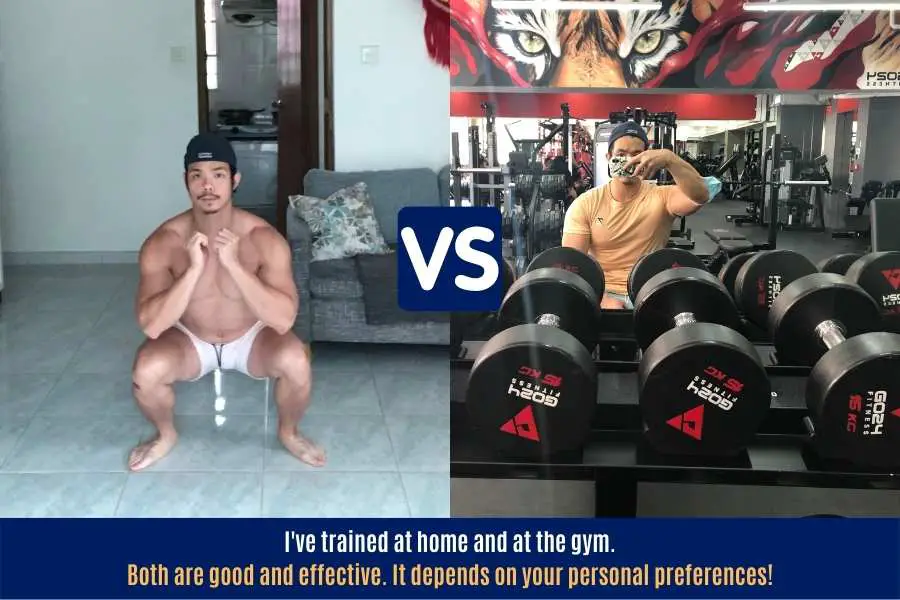
It’s impossible to say which one is better between gym vs home workouts; it comes down to personal preference. Most people prefer going to the gym.
But for those who have the space and money for home equipment, that is also a popular route.
What I can say is that home workouts can be just as effective as gym workouts.
In fact, I built my first 10lbs of muscle (and confidence) at home.
From there, I joined the gym to continue making gains!
If you’ve just started your training journey, you may be interested in my other post to find out how long it takes a skinny guy to gain muscle!
Conclusion
I’ve explained why and how it is possible to gain muscle without the gym.
Bodyweight workouts are a popular route for beginners to start building muscle at home.
And for a very good reason; it’s cheap, convenient, and most importantly, effective.
You can try the home workouts given in this post and apply the 9 tips I shared to make your bodyweight training even more effective to maximize muscle growth!
How will you be building muscle without the gym?
Feel free to send me a message if you have any questions! You can find my details on the “contact us” page.
You may also be interested in the downloadable Kalibre Blueprint PDF which details exactly how I gained 40lbs of lean muscle (it’s 100% free!). It details the exact exercises and nutrition (with printable worksheets) I used to go from skinny to ripped!
Thanks for reading guys!
Peace Out,
Kal
(Biochemistry BSc, Biomedical Sciences MSc, Ex-Skinny Guy)


